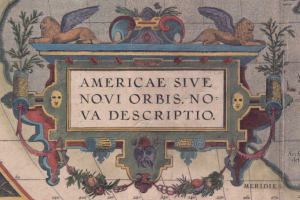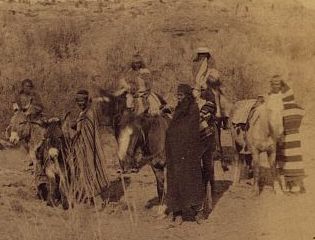American Indians at European Contact
Originally published as "Earliest American Explorers: Adventure and Survival"
by John W. Kincheloe, III
Used with permission from Tar Heel Junior Historian 47: 1 (Fall 2007): 6-8, copyright North Carolina Museum of History.
European explorers came to the "New World" o f North America in the 1500s. Before that time, the continent was an unknown place to them. These adventurers saw it as an entirely new land, with animals and plants to discover. They also met new people in this exciting New World—people with fascinating lifeways that the Europeans had never seen and languages they had never heard. This New World for Europeans was actually a very old world for the various people they met in North America. Today we call those people American Indians.
f North America in the 1500s. Before that time, the continent was an unknown place to them. These adventurers saw it as an entirely new land, with animals and plants to discover. They also met new people in this exciting New World—people with fascinating lifeways that the Europeans had never seen and languages they had never heard. This New World for Europeans was actually a very old world for the various people they met in North America. Today we call those people American Indians.
Archaeologists tell us that American Indians may have been on the North American continent for fifty thousand years. They were the first Americans, and they were great explorers, too. They didn't come to this continent all at once. It is thought that these ancient adventurers arrived at different times, over several thousands of years. They journeyed from Asia on foot or by boat. Their explorations took them through icy landscapes and along the coastlines. Eventually these earliest American explorers spread out over the entire continent.
Over time, their lives changed as they adapted to different environments. American Indians were creative. They found ways to live in deserts, in forests, along the oceans, and on the grassy prairies. Native peoples were great hunters and productive farmers. They built towns and traded over large distances with other tribes. These were the people the European explorers met when their ships landed in America.
As the English, French, and Spanish explorers came to North America, they brought tremendous changes to American Indian tribes. Europeans carried a hidden enemy to the Indians: new diseases. Native peoples of America had no immunity to the diseases that European explorers and colonists brought with them. Diseases such as smallpox, influenza, measles, and even chicken pox proved deadly to American Indians. Europeans were used to these diseases, but Indian people had no resistance to them. Sometimes the illnesses spread through direct contact with colonists. Other times, they were transmitted as Indians traded with one another. The result of this contact with European germs was horrible. Sometimes whole villages perished in a short time.
As early as 1585, English explorer Thomas Harriot observed how European visits to the small villages of coastal North Carolina Indians killed the Natives. He wrote:
Within a few days after our departure from every such [Indian] town, the people began to die very fast, and many in short space; in some towns about twenty, in some forty, in some sixty, & in one six score [6 x 20 = 120], which in truth was very many in respect of their numbers. . . . The disease was also so strange that they neither knew what it was nor how to cure it.
The introduction of European diseases to American Indians was an accident that no one expected. Neither the colonists nor the Indians had a good understanding of why this affected the Native people so badly.
The great impact of disease on the Native population of America is an important part of the story of European exploration. Experts believe that as much as 90 percent of the American Indian population may have died from illnesses introduced to America by Europeans. This means that only one in ten Natives survived this hidden enemy. Their descendants are the 2.5 million Indians who live in the United States today.
 New trade goods represented another big change that European explorers and colonists brought to American Indians. Soon after meeting their European visitors, Indians became very interested in things that the colonists could provide. In a short time, the Indians began using these new materials and products in their everyday lives. Native hunters were eager to trade prepared deer hides and other pelts for lengths of colored cloth. Metal tools such as axes, hoes, and knives became valuable new resources. Soon American Indian men put aside their bows and arrows for European firearms, powder, and lead shot. Trade items like metal pots often were cut up and remade into new tools or weapons. The desire to get European goods changed ancient trading patterns. The tradition of simple hunting for food began to become less important than getting animal hides to trade. Soon American Indians depended on European items for daily needs. Colonial traders also brought rum, and this drink caused many problems for some tribes. New trade goods brought from across the Atlantic Ocean changed American Indian lives forever.
New trade goods represented another big change that European explorers and colonists brought to American Indians. Soon after meeting their European visitors, Indians became very interested in things that the colonists could provide. In a short time, the Indians began using these new materials and products in their everyday lives. Native hunters were eager to trade prepared deer hides and other pelts for lengths of colored cloth. Metal tools such as axes, hoes, and knives became valuable new resources. Soon American Indian men put aside their bows and arrows for European firearms, powder, and lead shot. Trade items like metal pots often were cut up and remade into new tools or weapons. The desire to get European goods changed ancient trading patterns. The tradition of simple hunting for food began to become less important than getting animal hides to trade. Soon American Indians depended on European items for daily needs. Colonial traders also brought rum, and this drink caused many problems for some tribes. New trade goods brought from across the Atlantic Ocean changed American Indian lives forever.
A third big change connected to this new trade was slavery. European settlers needed workers to help build houses and clear fields. They soon realized that they could offer trade goods like tools and weapons to certain American Indian tribes that would bring them other Indians captured in tribal wars. These captured Indians were enslaved and "purchased" by European settlers. You might think that Africans brought to America were the only enslaved people. It is surprising to learn that before 1700 in the Carolinas, one-fourth of all enslaved people were American Indian men, women, and children. Before 1700 the port city of Charleston shipped out many enslaved Native people to work in the Caribbean or to be sold in northern cities like Boston. Slavery led to warfare among tribes and to much hardship. Many tribes had to move to escape the slave trade, which destroyed some tribes completely. In time, the practice of enslaving Native peoples ended. However, it had greatly affected American Indians of the South and the Southwest.
Many big changes happened to the first Americans soon after Europeans met them. But Indian people survived diseases, huge shifts in their cultures, and even the destructive slave trade. North Carolina recognizes eight proud and enduring tribes today: the Eastern Band of Cherokee, Lumbee, Haliwa-Saponi, Sappony, Occaneechi Band of the Saponi Nation, Waccamaw-Siouan, Meherrin, and Coharie. They are now greatly outnumbered by the descendants of the European colonists, but their strong presence honors their distant ancestors—those earliest of American explorers.
Educator Resources:
Grade 8: America’s Indian Removal Policies:Tales and Trails of Betrayal. North Carolina Civic Education Consortium. http://civics.sites.unc.edu/files/2012/04/IndianRemoval.pdf
References and additional resources:
Archaeological Institute of America. 2010. Introduction to archaeology. http://www.archaeological.org/education/archaeology
Excavating Occaneechi Town: An archaeology primer. LEARN NC. http://www.learnnc.org/lp/editions/occaneechi-archaeology-primer/?ref=search
Intrigue of the past: North Carolina's first peoples. Teacher's activity guide. http://www.rla.unc.edu/lessons/Menu/title.htm
National Archives (United Kingdom). What was early contact like between Europeans and Natives? http://www.nationalarchives.gov.uk/education/lesson37.htm
National Park Service. Archeology for kids. https://www.nps.gov/history/archeology/public/kids/index.htm
NC Office of State Archaeology. Online reports and summaries. http://www.archaeology.ncdcr.gov/ncarch/articles/articles.htm
UNC-Chapel Hill. Picturing the New World: The hand-colored De Bry engravings of 1590. http://www.lib.unc.edu/dc/debry/
Research Laboratories of Archaeology. Archaeology of North Carolina. http://rla.unc.edu/ArchaeoNC/index.htm
Research Laboratories of Archaeology. Video clips. http://www.rla.unc.edu/video/index.html
Image credits:
Hillers, John K, On a trading expedition [detail], 1873. LOT 11557-3, no. 83 [P&P], Library of Congress Prints and Photographs Division. http://www.loc.gov/pictures/item/2006676509/
Ortelius, Abraham, Americae sive novi orbis nova descriptio [detail], 1587. From the Outer Banks History Center, available in the North Carolina Maps Collection. http://dc.lib.unc.edu/u?/ncmaps,1103
1 January 2007 | Kincheloe, John W., III